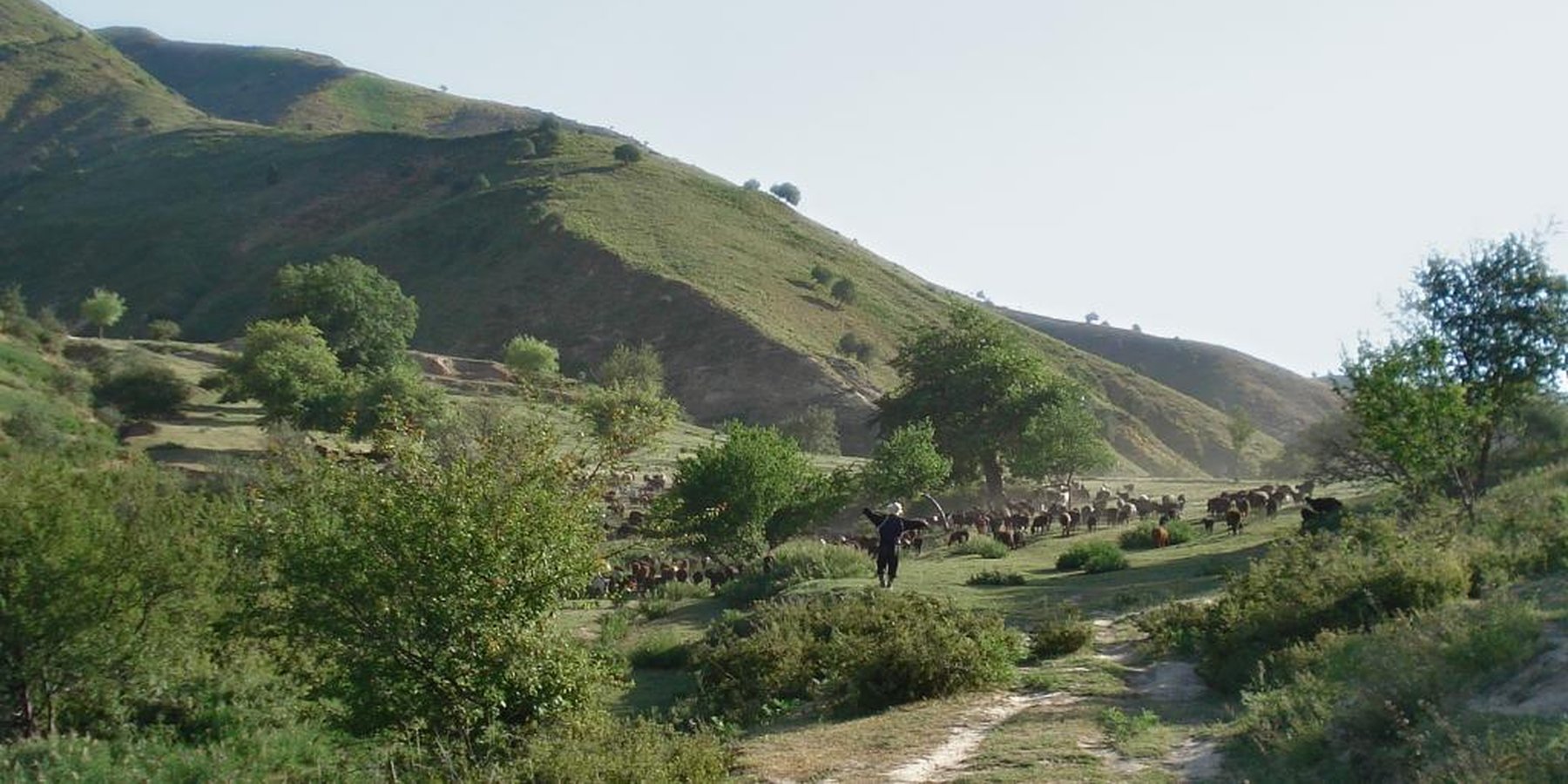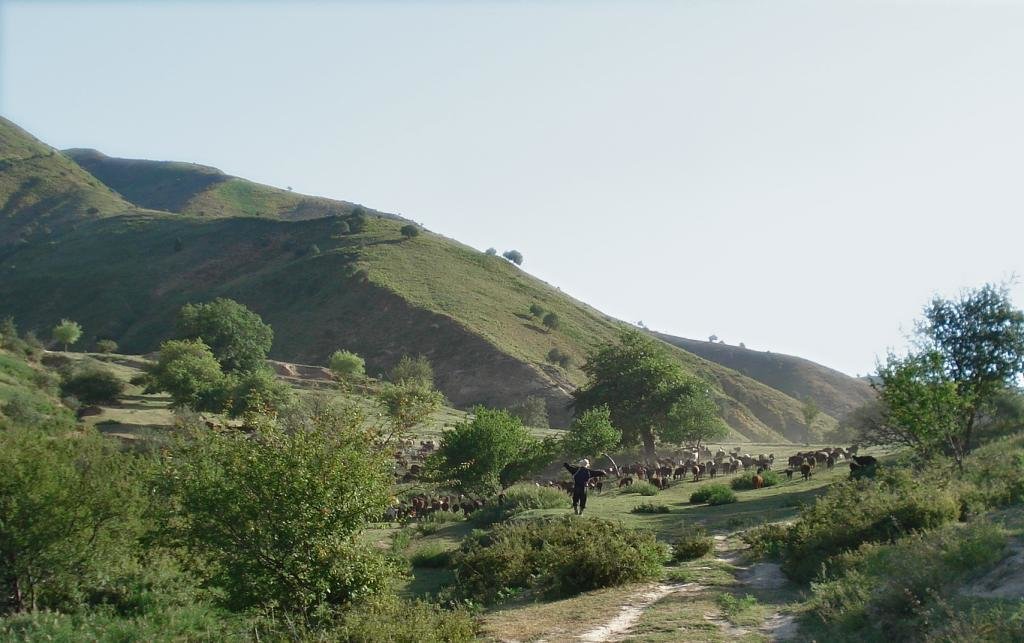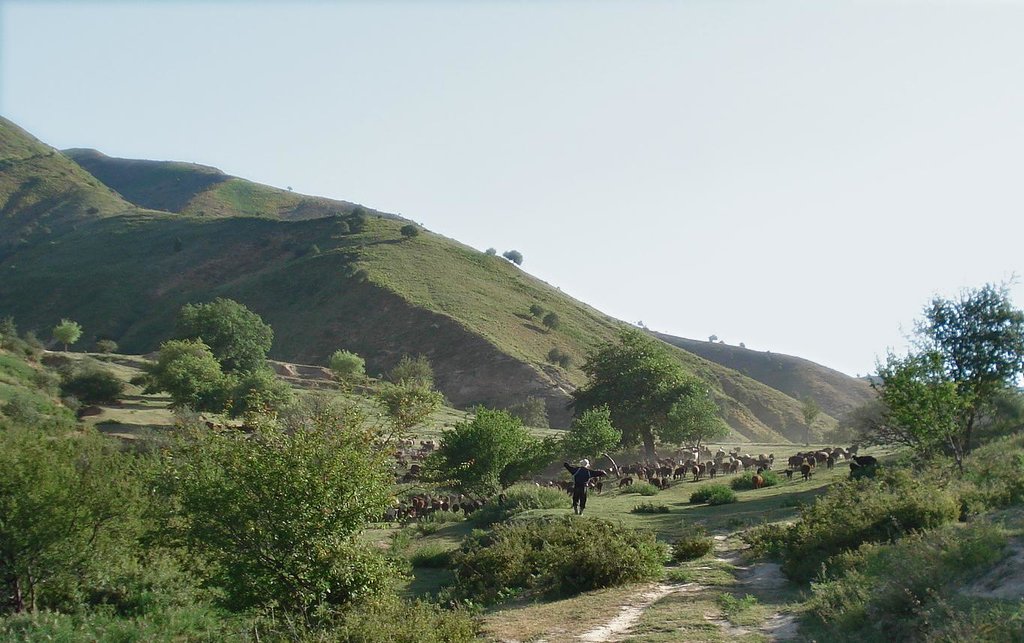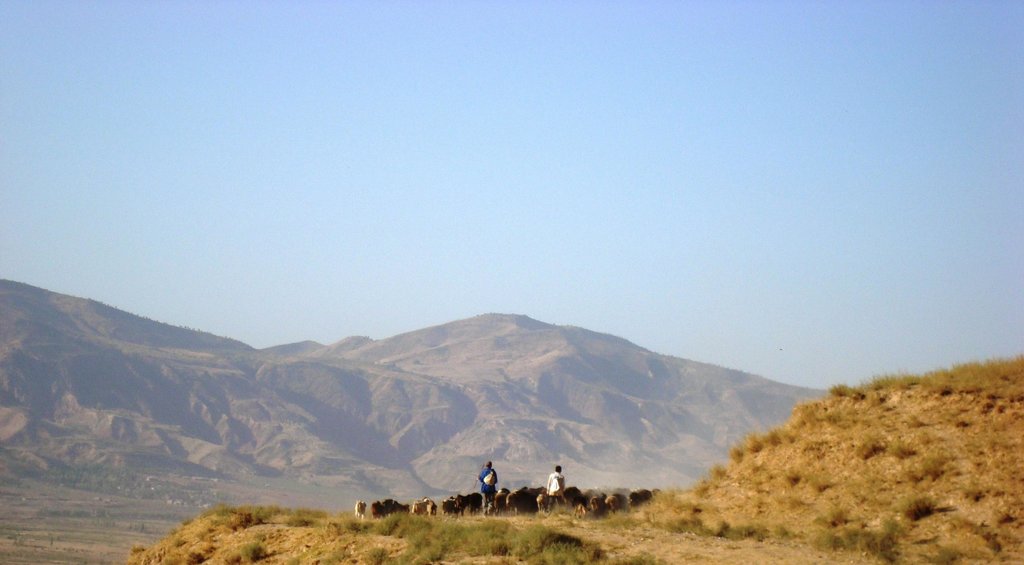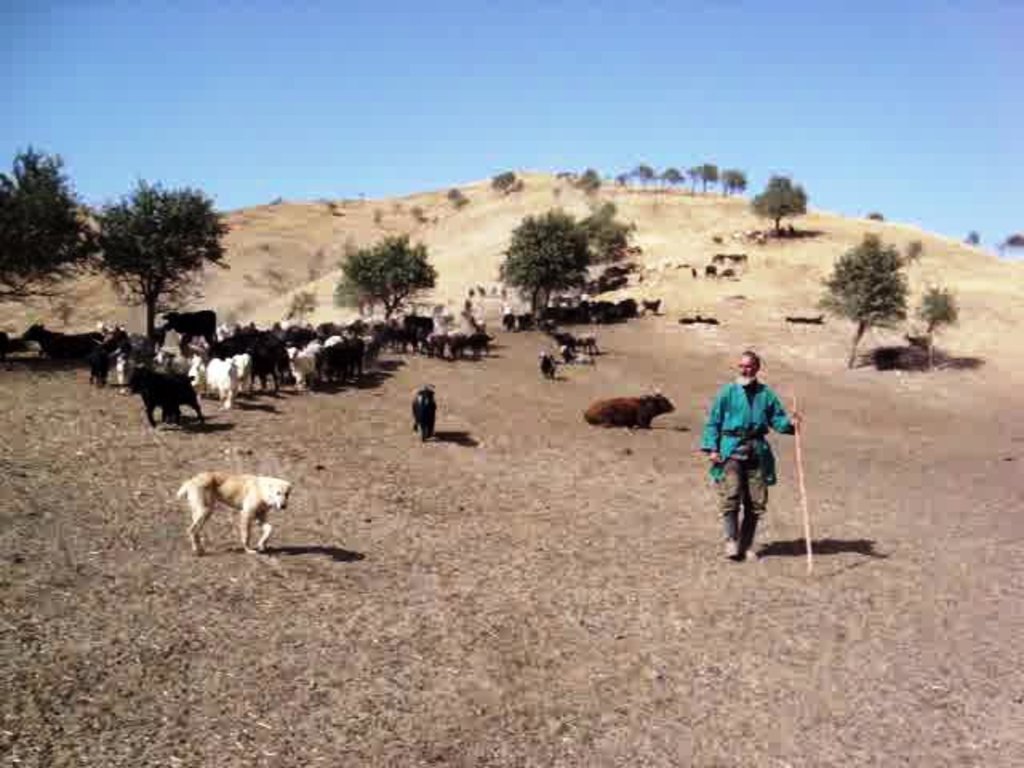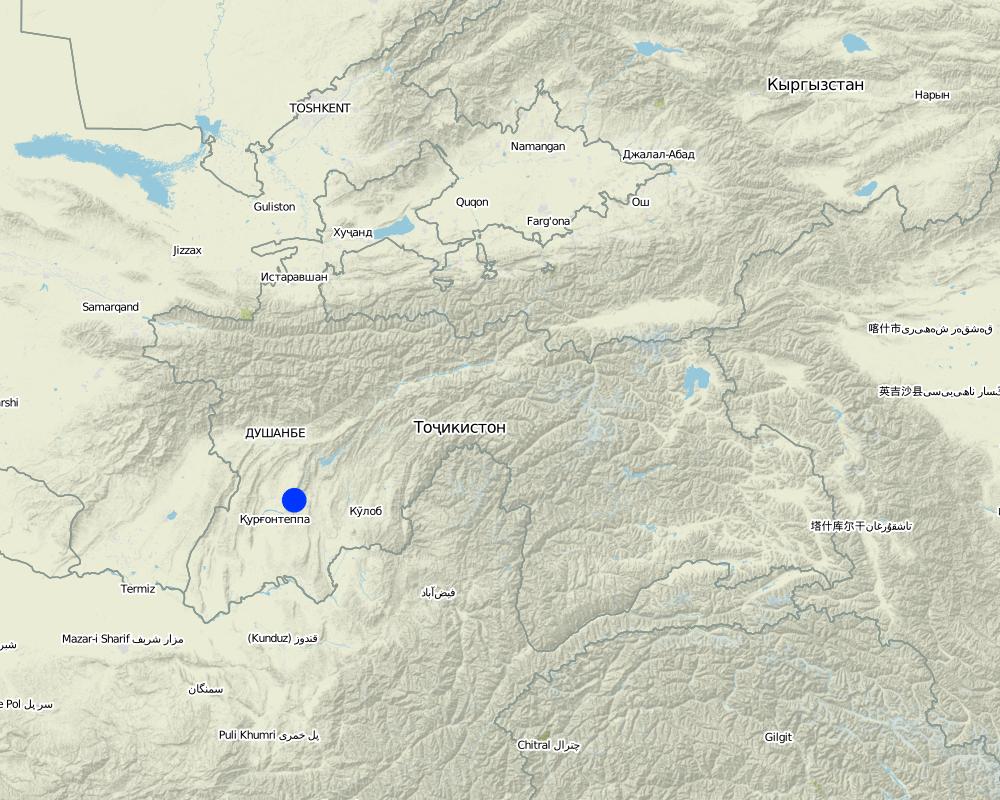Seminomadic individual herding [Tajiquistão]
- Criação:
- Atualização:
- Compilador/a: Christian Wirz
- Editor: –
- Revisor: David Streiff
Chupon / Dajmardei Khaspi (professional herding)
approaches_2565 - Tajiquistão
Veja as seções
Expandir tudo Recolher tudo1. Informação geral
1.2 Detalhes do contato das pessoas capacitadas e instituições envolvidas na avaliação e documentação da abordagem
Nome da(s) instituição(ões) que facilitou(ram) a documentação/avaliação da Abordagem (se relevante)
CDE Centre for Development and Environment (CDE Centre for Development and Environment) - Suíça1.3 Condições em relação ao uso da informação documentada através de WOCAT
Quando os dados foram compilados (no campo)?
15/08/2008
O/a compilador/a e a(s) pessoa(s) capacitada(s) aceitam as condições relativas ao uso de dados documentados através da WOCAT:
Sim
1.4 Referência ao(s) questionário(s) sobre tecnologias da GST
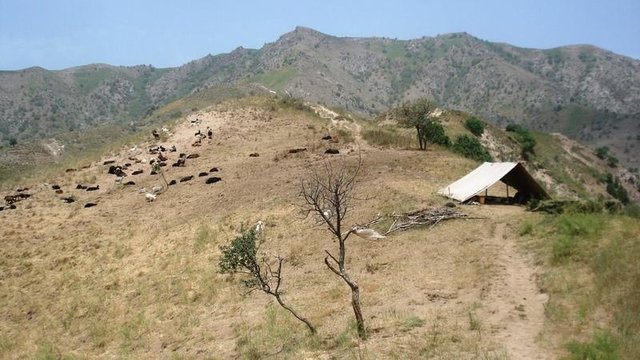
Daily and seasonal rotation on grassland [Tajiquistão]
Extensive grazing of sheep and goats by the means of a precise rotational scheme
- Compilador/a: Christian Wirz
2. Descrição da abordagem de GST
2.1 Descrição curta da abordagem
Pasture management by a single herder, assisted either by an employee or by his own grandchildren, in collaboration with the habitants of the nearby village Karsang.
2.2 Descrição detalhada da abordagem
Descrição detalhada da abordagem:
Aims / objectives: The herder chooses his territory by the criteria of biomass, vegetation cover and availability of surface water. In his work he gives special attention to fattening the animals, to not losing any of them and to giving back the right animals to the right tenant at the end of the season. For him it is important to be sincere with the tenants and to pay for lost animals.
Methods: Every method applied serves the target of having an obeying herd. The herder works with lots of patience. In the first two weeks he pays very much attention to keeping the herd together, so the animals get used to each other. The rotational grazing scheme also fulfills the requirement of fattening the animals. Grazing the animals by night-time is a method to make the animals obey better. Part of the work is the daily control of the herd to identify sick animals and treat them.The animals are by the way not led by the herder, but rather accompanied by him.
Stages of implementation: After apprenticeship the herder is entrusted with animals from the village and with the generated income can then gradually build up his own herd.
Role of stakeholders: The herder is responsible for the relation with his animals, with the villagers and with the forest department (contract).
2.3 Fotos da abordagem
2.5 País/região/locais onde a abordagem foi aplicada
País:
Tajiquistão
Região/Estado/Província:
Region of Republican Subordination
Especificação adicional de localização:
Faizabad
Map
×2.6 Datas de início e término da abordagem
Indique o ano de início:
1987
2.7 Tipo de abordagem
- Tradicional/Indígena
2.8 Principais metas/objetivos da abordagem
The Approach focused mainly on other activities than SLM (The focus of this approach is providing the own family with income and meat, by herding own and animals of other herders. It is very important for the herder to keep the animals healthy and to give them all back (the fattest possible) to their tenants.)
The herder's motivation to continue his father's work was that it enabled him to nourish his family. In his work he pays attention to fatten the animals enough to make them survive winter and to give them all back.
The SLM Approach addressed the following problems: The inhabitants of the village give the herder their animals because they know that the animals will be more healthy on the more natural pastures frequented by him compared with village pastures and because the animals get more reserves for winter-time. The herder claims that the animals need 50% less hay and fodder in winter than the animals grazed near the villages.
2.9 Condição que propiciam ou inibem a implementação de tecnologia/tecnologias aplicada(s) segundo a abordagem
Normas e valores sociais/culturais/religiosos
- Inibitivo
Being unable to go to parties and weddings.
Treatment through the SLM Approach: As it is not a problem for the herder (but perhaps for his wife and family?) the problem is not tackled.
Disponibilidade/acesso a recursos e serviços financeiros
- Inibitivo
Paying for lost animals.
Treatment through the SLM Approach: As long as the herder can find the lost animal, even if it is dead, he will not have to pay for it.
Quadro institucional
- Inibitivo
It is necessary to have good relations to obtain land from the forest administration.
Treatment through the SLM Approach: As M. worked for the forest department for many years, it was not a problem for him to lease land.
Quadro jurídico (posse de terra, direitos de uso da terra e da água)
- Propício
If tenure were more secure and land use free, M. would divide the rented land into pasture zone, orchard and cropland. This would ensure more self-sufficiency, but probably less income, because he could keep less animals on the reduced pasture area
- Inibitivo
Outro
- Inibitivo
For M. the principal problem are bears (and wolves) killing animals.
Treatment through the SLM Approach: Since he is not allowed to have a rifle to kill wild animals he has to chase them away with his dogs. This means that in summer, when the bears descend to lower areas for fruit in the orchards, he often has to keep awake by night.
3. Participação e papel das partes interessadas envolvidas
3.1 Partes interessadas envolvidas na abordagem e seus papéis
- Usuários de terra/comunidades locais
The herder himself is the protagonist. In some years he employed and educated young herders.
Caso várias partes interessadas foram envolvidas, indique a agência líder:
The herder himself implements the approach
3.2 Envolvimento do usuários de terra/comunidades locais nas diferentes fases da abordagem
| Envolvimento do usuários de terra/comunidades locais | Especifique quem estava envolvido e descreva as atividades | |
|---|---|---|
| Iniciação/motivação | Automobilização | Deciding to be a herder |
| Planejamento | Nenhum | |
| Implementação | Automobilização | Once M. knew how to treat the animals he could begin work with an own herd. |
| Monitoramento/avaliação | Nenhum | |
| Research | Nenhum |
3.4 Decisão sobre a seleção de tecnologia/tecnologias de GST
Especifique quem decidiu sobre a seleção de tecnologia/tecnologias a serem implementadas:
- Somente usuários da terra (iniciativa própria)
Explique:
The herder learnt his profession during an apprenticeship of one year
Decisions on the method of implementing the SLM Technology were made by by land users* alone (self-initiative / bottom-up). M. learned all the technologies from his father, but says, that he only does his job half as well as his father.
4. Suporte técnico, reforço das capacidades e gestão do conhecimento
4.1 Reforço das capacidades/ formação
Foi oferecida formação aos usuários da terra/outras partes interessadas?
Sim
Especifique quem foi capacitado:
- Equipe de campo/consultores
Caso seja relevante, especifique gênero, idade, status, etnia, etc.
Young men and boys.
Tipo de formação:
- Em exercício
Assuntos abordados:
Teaching of herding method: He tells his assistants not to beat the animals, not to shout at them, to treat animals fairly so they obey and to nourish them sufficiently so they don't walk away by night.
4.2 Serviço de consultoria
Os usuários de terra têm acesso a um serviço de consultoria?
Não
4.4 Monitoramento e avaliação
Comentários:
There were no changes in the Approach as a result of monitoring and evaluation: None
There were no changes in the Technology as a result of monitoring and evaluation: None
5. Financiamento e apoio material externo
5.1 Orçamento anual para o componente de GST da abordagem
Caso o orçamento exato seja desconhecido, indique a faixa:
- < 2.000
Comentários (p. ex. principais fontes de recursos/principais doadores):
Approach costs were met by the following donors: local community / land user(s) (All costs): 100.0%
5.2 Apoio financeiro/material concedido aos usuários da terra
Os usuários da terra receberam apoio financeiro/material para a implementação de tecnologia/tecnologias?
Não
5.3 Subsídios para entradas específicas (incluindo mão-de-obra)
Se a mão-de-obra pelos usuários da terra foi uma entrada substancial, isso foi:
- Comida por trabalho
Comentários:
Also paid in cash: Whereas his grandsons help him and get food therefore, the herder sometimes employs assistants who are paid.
5.4 Crédito
Foi concedido crédito segundo a abordagem para atividades de GST?
Não
6. Análise de impactos e declarações finais
6.1 Impactos da abordagem
A abordagem auxiliou os usuários da terra a implementar e manter as tecnologias de GST?
- Não
- Sim, pouco
- Sim, moderadamente
- Sim, significativamente
More biodiversity, less fertility decline, less cover reduction (compared to the grazing method used near the villages)
A abordagem concedeu autonomia aos grupos social e economicamente desfavorecidos?
- Não
- Sim, pouco
- Sim, moderadamente
- Sim, significativamente
Did other land users / projects adopt the Approach?
- Não
- Sim, pouco
- Sim, moderadamente
- Sim, significativamente
Young men herding in Faizabad area, one of them only a few ridges in the east of M.
Did the Approach lead to improved livelihoods / human well-being?
- Não
- Sim, pouco
- Sim, moderadamente
- Sim, significativamente
Whereas in the villages every family has to send someone as a herder once per month, M. earns money for his job and breeds his own animals. On the other hand the family structure is disrupted by the c
Did the Approach help to alleviate poverty?
- Não
- Sim, pouco
- Sim, moderadamente
- Sim, significativamente
In finacial terms, it did (by generating income), But in terms of education, it did not help.
6.2 Principal motivação dos usuários da terra para implementar a GST
- Produção aumentada
Animals get fatter than on the common pastures
- Consciência ambiental
The herder somehow has a consciousness of only taking from nature for what he has paid
6.3 Atividades de sustentabilidade de abordagem
Os usuários da terra podem manter o que foi implementado através da abordagem (sem apoio externo)?
- Sim
Caso afirmativo, descreva como:
The herder intends to continue his work as long as physically possible. He though wants to take less animals in the following year and instead more cows and less sheep and goats. He says that cows are easier to keep and in addition, he is paid four times more for a cow than for a sheep or a goat.
6.4 Pontos fortes/vantagens da abordagem
| Pontos fortes/vantagens/oportunidades na visão do usuário da terra |
|---|
| Each tenant has animals with their own comportment. M. only has to deal with a little number of tenants (and thus animal comportments), whereas the village herds are composed by animals of much more tenants. |
| animals can get used to each other. The composition of the big village herd is not always the same. |
| The herder is always the same and treats the animals fairly: he leads the animals slowly and doesn't shout at them or beat them. |
| Pontos fortes/vantagens/oportunidades na visão do/a compilador/a ou de outra pessoa capacitada |
|---|
| With around 600-700$ per season, the work as a professional herder is quite well-paid (for rural areas). (How to sustain/ enhance this strength: As soon as work in the foreigner (especially Russia) becomes scarce, herding will be more attractive again.) |
| For people with a tight relationship to nature and god (in the case of M.) this area is a good place, since remote. (How to sustain/ enhance this strength: There will probably continue to be religious, nature-bound young people.) |
6.5 Pontos fracos, desvantagens da tecnologia e formas de superá-los
| Pontos fracos/desvantagens/riscos na visão do usuário da terra | Como eles podem ser superados? |
|---|---|
| The trees damaged by the animals are a problem from the herder's point of view. | He sees the main problem in the past civil war, when lots of trees were chopped illegally. He says that tree-planting would not be a solution, because then grazing would not be possible anymore either. |
| Pontos fracos/vantagens/riscos na visão do/a compilador/a ou de outra pessoa capacitada | Como eles podem ser superados? |
|---|---|
| The way of living is not modern in the young peoples' eyes: They prefer social and urban to rural, solitary life. | As long as poverty predominates in the villages and cities cannot offer enough jobs to young people, agriculture and herding will stay interesting. Though, new (old) forms of herding might appear, such as herding in groups. |
| Night grazing makes sheep eat impalatable (poisonous) plants and than become sick (according to a specialist from CARITAS). | Training and workshops could be a platform for the discussion of such critical aspects. |
Links e módulos
Expandir tudo Recolher tudoLinks

Daily and seasonal rotation on grassland [Tajiquistão]
Extensive grazing of sheep and goats by the means of a precise rotational scheme
- Compilador/a: Christian Wirz
Módulos
Não há módulos


